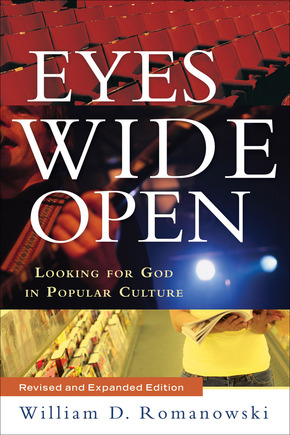As part of his Doctor of Ministry (DMin) in Ministry to Emerging Generations (Gordon-Conwell Theological Seminary), Tom’s written a number of book responses and given several short presentations (personal and group). In this series he not only “shares the wealth,” but also looks forward to your feedback as he refines his project: An argument for vocational discernment for graduate studies in the context of InterVarsity Christian Fellowship (Stay tuned to learn more!). Earlier posts on the program: Ministry to Emerging Generations and The Big Picture of Ministry to Emerging Generations.
Transforming Worldviews: An Anthropological Understanding of How People Change

William D. Romanowski, author of Eyes Wide Open: Looking for God in Popular Culture (Grand Rapids, MI: Brazos Press, 2001), has quite a reputation among Coalition for Christian Outreach (CCO) staff for cultural engagement. I was surprised that the first item to catch my attention was Romanowski’s reference to 93% of households owning a VCR (12). How quickly technology and popular culture change–great to take a look at a friend’s “Revised and Expanded Edition” with a whole new introduction. Writing a book which dives into popular culture (who is familiar with Eyes Wide Shut today?) is no easy task. Going beyond Christian consumption of and ghettoization of 20th century popular, mass art requires:
An engaged, critical, and productive involvement with the popular arts—grounded in a faith vision that encompasses all of life and culture (14).
Romanowski not only sets the stage for engaging the weaknesses, achievements, virtues, and laments of popular arts, but also offers a powerful application of his technique (Appendix 1, 155-161) in Appendix 2: Are you ready to go back to Titanic? (162-171). Considering the film’s popularity and long term viability (based on a variety of factors including actors, director, and a rich fictional story in the context of an engaging historical event), Titanic was an excellent choice of illustration.
No doubt a significant confusion regarding the Christian pop culture industry is Gallop’s conclusion, “The stark fact is, most Americans don’t know what they believe or why” (27). I particularly appreciate the work of Christian Smith on Moralistic Therapeutic Deism (MTD) —material Romanowski should interact with in a future edition. As for Christian pop art, the quote from Maxim Magazine continues to be “on the mark” for much of my experience in this genre and the spaces where it is advocated and/or sold:
In a reader survey by a magazine geared toward 18-to-34-year-old men, seventy-five percent said they would rather kill themselves with a steak knife than watch an episode of Touched by an Angel (78).
It is not only difficult to connect maturing men with popular Christian subculture and to encourage them to return after they exit, but also those with intellectual passions and concerns. It is important to press into developing “family friendly” and “created in the image of God” art which engages the whole family (dare I say the “people of God?”) with head, heart, and hands.
Can one raise up “interpretative communities” in the context of seeker-orientated, mass Evangelicalism? Communities with a passion for digging into the subject, content, and evaluation of popular artwork are needed (151). Personally, I have found it a very hard task to raise and continue to develop over the long haul small groups of stewards (or “culture-makers”). In the short term they may be fueled by worldview (or Biblical story) application books such as Eyes Wide Open, but they are hard to sustain considering the demands upon one’s time, energy, and willingness to submit accountability as part of the discernment process. The interpretative communities demand core teams of leaders (i.e., more than one lynchpin person) seeking not only “the meaning” offered by popular culture’s stories and the foundational understandings of the Christian faith (i.e., Christian worldview), but also prayer with intergenerational mentoring and action. The emphasis upon prayer and action as found in Os Guinness’ Renaissance: The Power of the Gospel However Dark the Times (InterVarsity Press, 2014) is important to keep in mind when reading and discussing Romanowski’s Eyes Wide Open.
Tom enjoys daily conversations regarding living out the Biblical Story with his wife Theresa and their four girls, around the block, at Elizabethtown Brethren in Christ Church (where he teaches adult electives and co-leads a small group), among healthcare professionals as the Northeast Regional Director for the Christian Medical & Dental Associations (CMDA), and in higher ed as a volunteer with the Emerging Scholars Network (ESN). For a number of years, the Christian Medical Society / CMDA at Penn State College of Medicine was the hub of his ministry with CMDA. Note: Tom served with InterVarsity Christian Fellowship / USA for 20+ years, including 6+ years as the Associate Director of ESN. He has written for the ESN blog from its launch in August 2008. He has studied Biology (B.S.), Higher Education (M.A.), Spiritual Direction (Certificate), Spiritual Formation (M.A.R.), Ministry to Emerging Generations (D.Min.). To God be the glory!

Leave a Reply